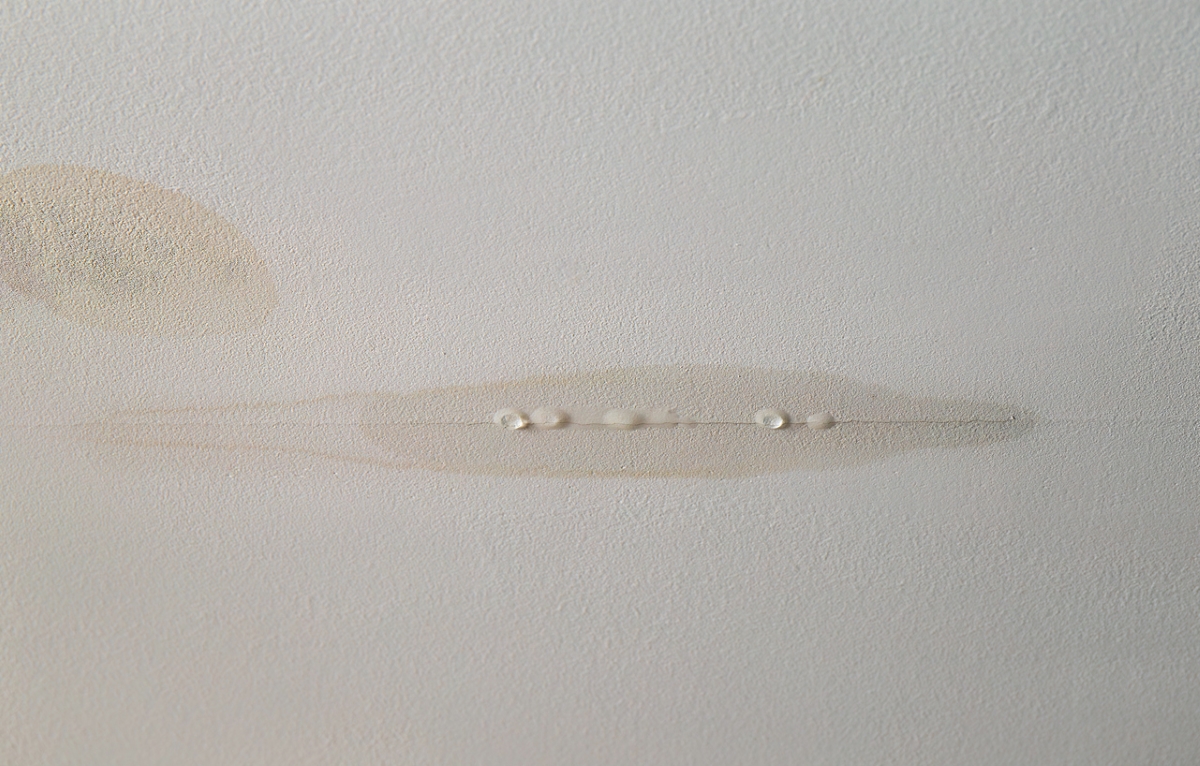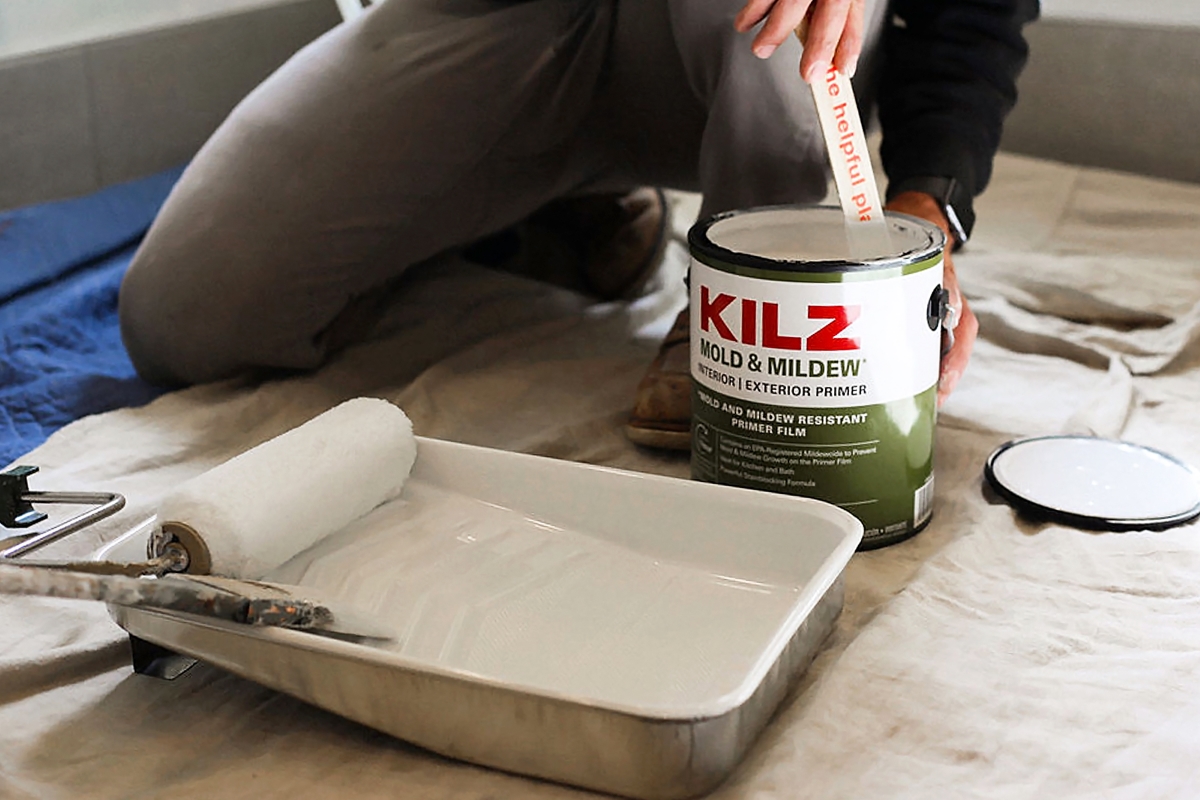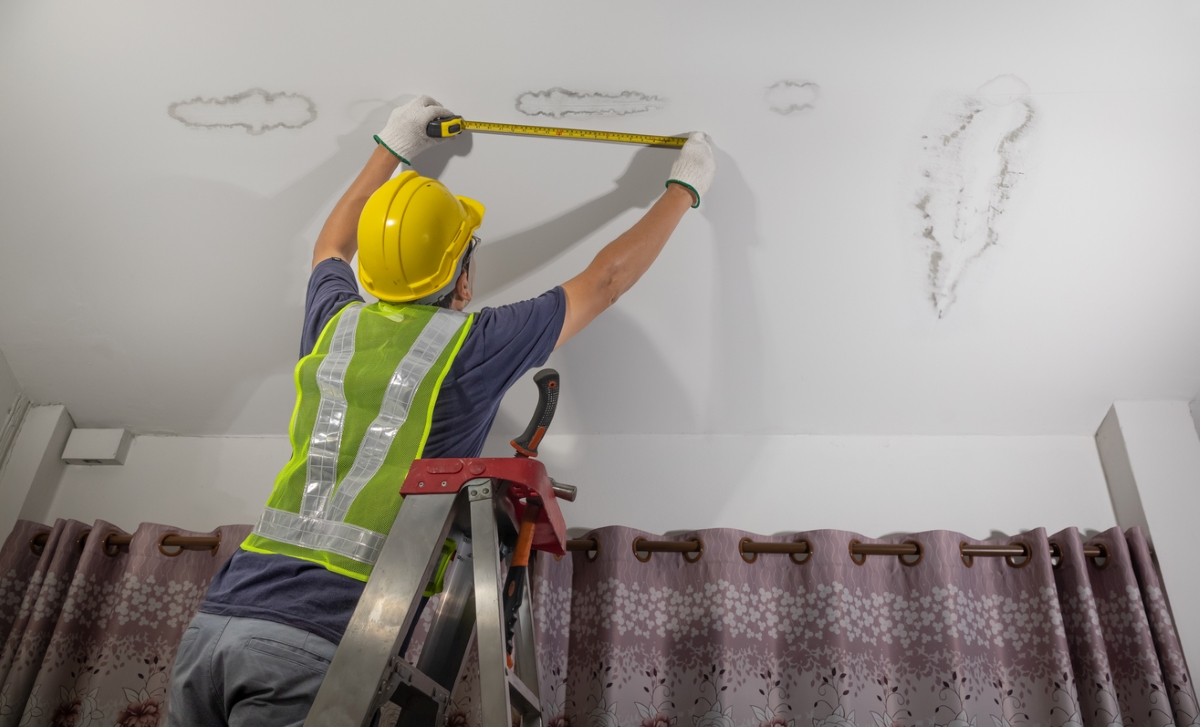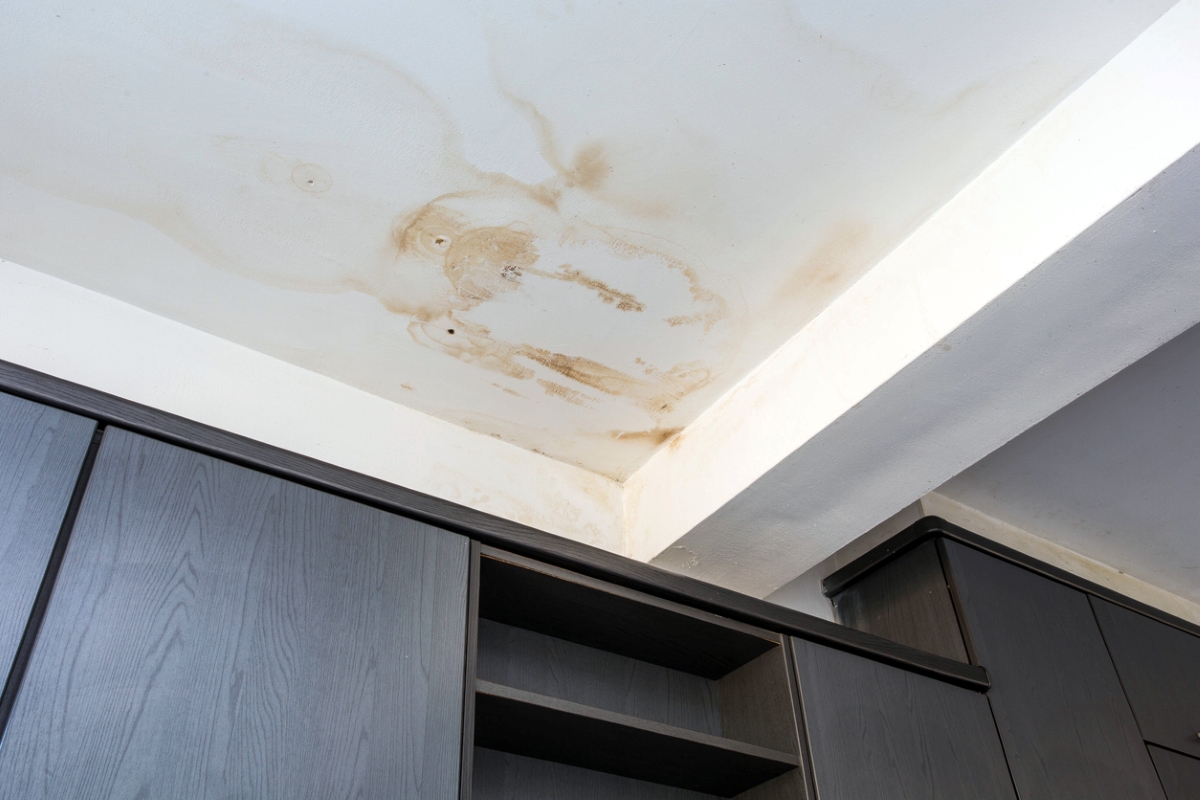We may earn revenue from the products available on this page and participate in affiliate programs. Learn More ›
Q: I recently noticed some water stains on the ceiling of my living room. I’m not sure where they came from, but the ceiling feels dry to the touch now. What’s the best way to cover them up? And since the stains are dry, can I assume that whatever caused them is no longer a threat to my home?
A: A water stain on the ceiling is usually a byproduct of a roof, heating appliance, or plumbing leak that seeped through the ceiling and evaporated, leaving you with an unsightly patch of dried, discolored moisture spots on ceiling tiles or paint.
According to David Ragsdale, master water restorer for Servpro, there are many causes of water damage on ceilings, including:
- Roof covering or vent damage, or poor installation of vents and roofing
- Plumbing vent boot/flashing issues
- Chimney flashing/construction defects
- HVAC drain leaks or overflows
- Moisture condensation in HVAC supply line
- Inadequate attic insulation
- Plumbing supply or drain line problems
“Visual inspection is the primary way to identify the causes,” Ragsdale says. Although you can paint over a ceiling water stain without addressing the leak that caused it, you run the risk of additional staining, more serious ceiling repair costs, or structural or electrical damage. “There are many cases where a homeowner painted over a stain only to have it return,” says Ragsdale. The steps below will help you pinpoint the cause of the stains, and to clean, prime, and paint over water stains. And if the reason for staining seems too daunting, heed Ragsdale’s advice below on when to call in the pros for a water-damaged ceiling.
Step 1: Identify and repair the root cause.

The most important step when removing water stains is figuring out the source of the water leak (or in rarer cases, the flood). Once you have this information you can fix the water stain yourself, or research who to call for a water leak in the ceiling. Ragsdale lists signs homeowners can look for to determine the root cause. Although homeowners sometimes can inspect sloped or pitched roofs from the ground, “flat roofs would likely require a homeowner to climb onto the roof,” he says.
- Roof covering damage: look for crumbling shingles or compromised flashing (the weatherproofing material installed on the roof).
- Roof vents for attics, along with plumbing vents, come in a variety of types, says Ragsdale. Damaged vents and weakened seals can lead to leaks. Spotting these leaks typically requires climbing onto the roof.
- Damaged or poorly installed flashing typically surrounds chimneys, roof valleys, and some roof vents. Ragsdale says to look for rusty areas, flashing separated from the surface, or cracks and gaps in the sealer (caulking) around the flashing. If the chimney flashing appears intact and the leak is in that area of the ceiling, look for cracks in mortar or areas of missing mortar around the chimney’s bricks.
- HVAC units create condensation, and they can leak if the drain line or drain pan is poorly installed or clogged. Check the spot where the drain exits the home to see if water is exiting, or look for standing water in the unit’s drain pan.
- HVAC supply lines condensate during hot weather. The condensation will gather on the outside of ductwork that is not insulated well; look for water droplets on or dripping from ducts if you have condensation stains on ceiling spots below ducts.
- Poor insulation in the attic also can cause ceilings to form condensation on hot days. If water droplets are clinging to the ceiling’s surface, this is likely the cause of moisture condensation stains on ceiling areas.
- Plumbing fixtures, along with supply and drain lines, can cause water damage on ceilings. Look for cracks in the fixture or damaged seals around it. In the case of a leaky radiator, find and fix the unit’s body, valve, pipe, or bleed point. You can turn off the water supply inside the home and check the meter; if it continues moving, there is likely a leak. If the leak is under an upstairs bathroom, check sinks and toilets. Repair damaged toilet caulking and unclog sinks or drains that could flood the floor.
Step 2: Clean the stain with bleach.
Once you’ve dealt with the underlying problem, you’re ready to remove water stains from the ceiling. Cleaning the stained area of the ceiling with a mild homemade bleach solvent (1 cup of bleach and 3 cups of warm water) will fade the mark and remove lingering mildew, grease, dirt, or dust that can prevent primer and paint from adhering to the ceiling.
- Set a drop cloth on the floor under the ceiling stain and prop up a ladder to reach it.
- Don protective gloves and goggles, climb the ladder, and wipe down the stain with a clean sponge saturated in the bleach solution.
- Rinse the bleach solution off the ceiling with water from a spray bottle, then wipe the damp area dry with a clean cloth.
- Once the ceiling is completely dry, cover the ceiling trim with painter’s tape to protect it from primer and paint.
Step 3: Apply a base coat of stain-blocking primer.

At this stage, it can be tempting to slap a coat of paint directly over the water stain and call it a day. However, interior latex paints, which are commonly applied to ceilings, are not the best choices to apply over a water stain because they’re water-soluble. When a water stain comes into contact with latex paint, the stain dissolves into the wet paint layer as the paint dries, causing the discolored mineral contents of the stain to show through the paint to the ceiling surface once again.
Your best option for a base coat to cover water stains on the ceiling is an oil-based, mold-resistant, stain-blocking primer in a shade closely matching that of the existing ceiling. Oil-based stain-blocking primers such as KILZ Stainblocking Ceiling Paint can keep water stains from bleeding through. These stain-blocking primers also contain a high volume of binders (polymers that bind paint pigments), so that the primer can adhere to the surface for the long run.
How you apply the primer and paint depends on ceiling style. If you have a smooth ceiling, roll the primer over the water stains using a paint roller with an extension and a ⅜-inch nap roller cover, then let the primer dry for 2 hours or as instructed by the primer packaging. For a textured ceiling, opt instead for a thicker nap roller cover (¾ -inch to 1¼ -inch nap) or spray on the primer using a can of stain-blocking primer.
Step 4: Cover the primer with ceiling paint.

The primed area of the ceiling will usually be a few shades lighter or darker than the rest of the ceiling, which can draw the eye to the stained area. Painting over the primed area will help color-match it with the rest of the ceiling for a professional-quality cover-up.
Whether you have a smooth or textured ceiling, you can use either a latex (water-based) or an alkyd (oil-based) ceiling paint over the oil-based primer. Latex options dry faster and produce fewer fumes from volatile organic compounds (VOCs) than oil-based counterparts. Just make sure to purchase ceiling-specific paint like Glidden Ceiling Paint, which is usually thicker than traditional paint and has a non-reflective finish that helps hide minor imperfections.
To paint the ceiling, choose a paint that matches the color of your ceiling. Apply it with a roller (choose a ⅜-inch nap cover for a smooth ceiling, or a ¾ -inch to 1-¼ -inch nap for a textured ceiling). Let the first coat of paint dry for up to 4 hours or as instructed by the product packaging. Apply a second coat if you want more even coverage.
After the second coat dries, the ceiling should look as though it had never been stained.
When to Call a Professional

Homeowners can only repair a water stain permanently if they have determined and eliminated the cause, Ragsdale says. He cautions that a stained ceiling might be only part of the ceiling repair needed. “There may be underlying materials, such as framing, that need to be cleaned and dried,” he says. He recommends contacting a professional to “evaluate the damage and determine the best course of action.”
It’s particularly important to call a professional, he says, if:
- Drywall is sagging
- Mold growth is suspected
“These situations represent safety hazards,” says Ragsdale. Although water stains don’t always mean there is mold, they could, and mold may require remediation. Likewise, some roofing, chimney, and plumbing repairs require a professional to repair the underlying cause before you clean up the stain per the steps above.
Although fixing the cause of water marks on the ceiling can cost upward of $3,000, costs and safety concerns arise if you don’t address the problem. Generally, water damage involves a small part of the ceiling is a small repair, but extensive damage might require replacing an entire ceiling. Many of the best water damage restoration services work directly with homeowners insurance companies to help coordinate claims.
How to Prevent Water Damage to Ceilings
Addressing the cause of water stains on a ceiling goes a long way toward preventing future damage. Ragsdale also advises keeping HVAC drains, gutters, and downspouts free of dirt and debris to prevent clogging that leads to water stains on the wall or ceiling of the home’s interior, along with potential damage.
Vigilance is important too. “Homeowners should do periodic inspections of their entire property,” says Ragsdale. He says they don’t have to be elaborate, but consistent (two to three times per year). For example, if you notice water spots on ceiling paint, it could be the sign of a small problem that will get bigger. “A general awareness of the overall condition of one’s home can pay significant dividends toward preventing small problems from becoming major repairs,” says Ragsdale.


